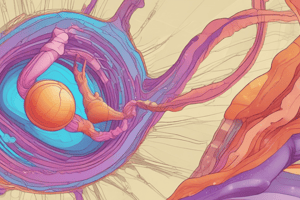Podcast
Questions and Answers
What is the net gain of ATP from one molecule of glucose during glycolysis?
What is the net gain of ATP from one molecule of glucose during glycolysis?
- 0 ATP
- 2 ATP (correct)
- 6 ATP
- 4 ATP
The process of glycolysis occurs in the mitochondria and requires oxygen.
The process of glycolysis occurs in the mitochondria and requires oxygen.
False (B)
What byproduct is produced during anaerobic respiration in muscle cells?
What byproduct is produced during anaerobic respiration in muscle cells?
lactic acid
The Krebs cycle converts a 6 Carbon compound back to a 4 Carbon compound by losing two _______ and four pairs of hydrogen.
The Krebs cycle converts a 6 Carbon compound back to a 4 Carbon compound by losing two _______ and four pairs of hydrogen.
Match the following processes with their descriptions:
Match the following processes with their descriptions:
What is the main disadvantage of anaerobic respiration compared to aerobic respiration?
What is the main disadvantage of anaerobic respiration compared to aerobic respiration?
Fermentation is a type of aerobic respiration.
Fermentation is a type of aerobic respiration.
What do plants and animals use anaerobic respiration for?
What do plants and animals use anaerobic respiration for?
During anaerobic respiration, yeast converts glucose into ________ and ethanol.
During anaerobic respiration, yeast converts glucose into ________ and ethanol.
Match the following products to their corresponding fermentation processes:
Match the following products to their corresponding fermentation processes:
Flashcards are hidden until you start studying
Study Notes
ATP Formation
- Formation of ATP involves the addition of a third phosphate group to ADP, requiring energy.
- This energy is stored in the high-energy bond formed during ATP synthesis.
Waste Removal
- Metabolism generates waste products such as urea, carbon dioxide, and water.
- The process of eliminating these waste products is known as excretion.
Stages of Respiration
-
Glycolysis:
- Process of breaking down glucose (6-carbon) into two 3-carbon pyruvate molecules.
- Takes place in the cytoplasm and is anaerobic (does not require oxygen).
- Requires 2 ATP to initiate, resulting in a net gain of 2 ATP per glucose molecule (4 ATP produced).
-
Krebs Cycle:
- Pyruvate enters the mitochondrion's matrix, releases CO2 and 2 hydrogen atoms.
- Forms acetyl coenzyme A, which enters the Krebs cycle, joining a 4-carbon compound to create a 6-carbon compound.
- The cycle includes a series of reactions, releasing 2 CO2, 4 hydrogen pairs, and 1 ATP.
-
Electron Transport Chain:
- Occurs in the cristae of mitochondria, utilizing oxygen to produce ATP.
- Electrons from hydrogen atoms are transferred through carrier molecules, generating energy for ATP synthesis.
- Final step involves combining hydrogen ions and electrons with oxygen to create water, which is usable by cells.
Anaerobic Respiration
- Takes place without oxygen, leading to the production of lactic acid in certain cells (e.g., muscle cells).
- Reduces cellular efficiency, lowers pH, and can cause cramps and stiffness.
- Increased breathing post-exercise helps reconvert lactic acid to glucose in the liver.
Aerobic Respiration Equation
- Chemical Reaction: C6H12O6 + 6O2 → 6CO2 + 6H2O (Glucose + Oxygen = Carbon Dioxide + Water).
Fermentation
- A form of anaerobic respiration utilized for energy production in low-oxygen environments.
- Advantages: Provides energy in conditions where oxygen is scarce.
- Disadvantages: Limited to 2 ATP production compared to the 38 ATP from aerobic respiration; produces toxic byproducts requiring excretion.
- Applications: Alcohol production, bread-making, yogurt, cheese production, and the creation of antibiotics and human growth factors.
Mandatory Practical: Ethanol Production by Yeast
- Prepare a 10% w/v glucose solution (400 ml), divide into two flasks (200 ml each).
- Add yeast to one flask ('yeast + glucose') and leave the other as a control without yeast.
- Use fermentation locks filled with water to monitor gas production.
Overview of Respiration
- Process that converts chemical energy in food to usable energy forms for cellular functions.
- Types:
- Anaerobic (no oxygen, small energy output).
- Aerobic (requires oxygen, large energy output).
Metabolism
- Involves millions of chemical reactions in living cells divided into:
- Anabolic Reactions: Construct complex compounds from simpler ones, requiring ATP for energy.
- Catabolic Reactions: Break down complex molecules into simpler forms, releasing energy for ATP synthesis.
ATP Functions
- Stores energy from reactions (e.g., photosynthesis, respiration) in a useable form.
- Transfers energy to locations in the cell where it is needed.
Energy Cycle
- Respiration provides energy as ATP, which is used by cells and converted back to ADP and inorganic phosphate upon energy release.
- ADP and free phosphate can be reassembled into ATP if energy is available, maintaining the cycle.
Studying That Suits You
Use AI to generate personalized quizzes and flashcards to suit your learning preferences.




